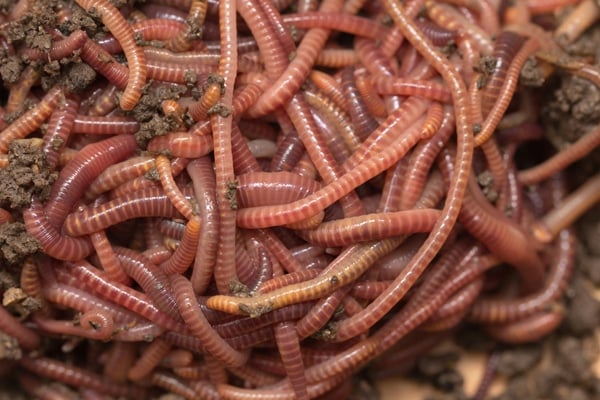Why Red Wigglers Are the Ultimate Ally for Your Garden's Health
The integration of red wigglers right into garden administration techniques provides an engaging case for improving dirt health and general yard vitality. These microorganisms are not just composters; they are critical in developing nutrient-rich castings that considerably boost soil structure and advertise a thriving community.
Advantages of Red Wigglers
These earthworms, clinically recognized as Eisenia fetida, play a crucial duty in boosting soil quality. This process not only enriches the soil but also improves its structure, promoting better aeration and drainage.
Furthermore, red wigglers add to enhanced microbial activity within the soil. The castings they produce are teeming with beneficial microorganisms that help decompose organic products and launch necessary nutrients, making them conveniently offered for plant uptake. This biological activity fosters a growing ecological community, which is essential for plant health and wellness and durability.
Additionally, red wigglers assist in dampness retention within the dirt, minimizing the frequency of watering requirements. Their delving activity aerates the dirt, developing paths for water and air to penetrate deeper layers, therefore boosting origin growth.

Exactly How to Make Use Of Red Wigglers
Making use of red wigglers in your gardening practices can significantly boost soil wellness and efficiency. To efficiently integrate these beneficial worms, start by setting up a vermicomposting system. This can be performed in a designated container, which should be well-ventilated and consist of a bedding product such as shredded paper, coconut coir, or aged compost.
Present the red wigglers into this atmosphere, guaranteeing they have access to a well balanced diet of kitchen area scraps like veggie peels, coffee grounds, and crushed eggshells. Stay clear of citrus, dairy, and meat, as these can draw in parasites and cause smell problems.
(Red Wiggler Express)Maintain optimum conditions by maintaining the moisture level regular-- damp yet not soggy-- and making sure the temperature ranges in between 55 ° F and 77 ° F. Red Wiggler Express. Monitor the container routinely, including even more bedding and food as needed
Once your worms have refined the natural material, you will see a rich, dark blend accumulating at the end of the container. This can be used to enhance the dirt in your yard beds or potted plants, thereby producing a growing ecosystem that promotes healthy and balanced plant development. Red wigglers truly function as a sustainable resource for any type of horticulture fanatic.
Nutrient-Rich Castings Explained
Vermicomposting yields an amazing product known as worm castings, which are loaded with crucial nutrients beneficial for plant development. These spreadings are the outcome of the food digestion of raw material by red wigglers, changing waste into a nutrient-dense fertilizer. Rich in nitrogen, phosphorus, potassium, calcium, and magnesium, worm castings give a well balanced resource of nutrition that supports the total wellness of plants.
The nutrient account of worm castings transcends to that of traditional compost. This is mostly due to the microbial activity that takes place during the digestion procedure, which boosts the bioavailability of nutrients. Spreadings consist of useful microorganisms that advertise soil health and plant vigor.
Furthermore, worm spreadings are defined by their slow-release residential properties, guaranteeing that nutrients are readily available to plants over a prolonged period. This progressive release lessens the risk of nutrient Lake Rhodhiss Bait leaching, making it an eco-friendly option for gardeners.
Integrating worm castings into your horticulture routine not just enriches the dirt but likewise fosters lasting methods, eventually resulting in much healthier plants and a much more productive yard.
Enhancing Soil Structure
Worm spreadings, created by red wigglers, add to a healthy and balanced dirt ecosystem through their distinct structure of natural issue and helpful microbes. When mixed right into yard dirt, these spreadings boost oygenation, permitting for far better origin infiltration and growth.
In addition, worm spreadings assist to accumulated dirt bits, developing globs that enhance drain and minimize soil compaction. This aggregation supports the retention of moisture while preventing waterlogging, creating an optimal setting for plant origins. Healthy and balanced dirt structure also promotes the spreading of valuable germs and fungis, additionally improving the soil's capacity to sustain plant.
Furthermore, the high organic content of worm spreadings works as a slow-release source of nutrients, ensuring that plants obtain vital aspects in time as opposed to in a fast, potentially harmful ruptured. Therefore, integrating worm castings right into your gardening technique not just enriches the dirt nutritionally however also promotes a robust and resistant dirt structure, essential for prospering plants.
(Red Wiggler Express)
Bring In Beneficial Microorganisms
Drawing in advantageous microorganisms is crucial for keeping a dynamic and productive yard ecological community - Red Wiggler Express. These organisms, consisting of pollinators, predacious pests, and microorganisms, contribute substantially to soil health and wellness, insect control, and plant growth. Red wigglers, or Eisenia fetida, play a crucial function in this process by boosting the general biodiversity of the yard
To pull in advantageous microorganisms, garden enthusiasts should focus on developing a friendly atmosphere. This can be achieved by including diverse plant varieties that bloom at various times, guaranteeing a constant supply of nectar and pollen. In addition, offering environments such as native wildflowers, bushes, or insect resorts can motivate beneficial bugs to grow.

Verdict
In conclusion, the assimilation of red wigglers right into gardening techniques dramatically improves soil wellness and promotes lasting environments. Their ability to transform organic waste into nutrient-rich spreadings improves dirt structure, oygenation, and wetness retention, fostering a helpful atmosphere for plant growth.